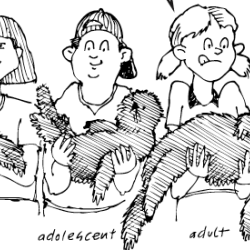Source Institutions
Source Institutions
Add to list Go to activity
Activity link broken? See if it's at the internet archive

In this graphing activity (on pages 33-40), learners investigate how much and what kinds of food sea otter pups eat during their first year of life. Learners discover that young sea otters eat more than two times the amount of food needed for a boy or girl of the same weight. The "Think It Over" section prompts learners to consider how a oil spill would affect otters' crucial food supply. This activity can be used with math lessons involving graphing, marine science lessons, and even comparative nutrition lessons.
- 10 to 30 minutes
- 1 to 2 hours
- 1 cent - $1 per group of students
- Ages 8 - 14
- Activity
- English, Spanish
Quick Guide
Materials List (per group of students)
- Beachcomber's Guide or pictures of kelp forest animals downloaded from the Web or other sources - photocopy for each participant
- 1 calculator
- colored pencils
- 1 sheet 12 x 18 inch white construction paper
Subjects
-
Life Sciences
-
Diversity of Life
- Animals
-
Diversity of Life
-
Mathematics
-
Data Analysis and Probability
- Data Analysis
-
Measurement
- Rate
-
Data Analysis and Probability
-
The Nature of Science
-
The Scientific Process
- Gathering Data
- Formulating Explanations
-
The Scientific Process
Informal Categories
- Animals
- Nature and Environment
Audience
To use this activity, learners need to:
- see
- read
Learning styles supported:
- Involves teamwork and communication skills
Designed specifically for
- Rural dweller
Culture, ethnicity, and gender
-
Girls
- Explicity developed for this group
Other
Foreign language versions of this resource:
Components that are part of this resource:
Includes alignment to state and/or national standards:
This resource is part of:
Access Rights:
- Free access
By:
- University of Nebraska State Museum; Nebraska Cooperative Extension 4-H Youth Development
Source Collection
- Science After School Consumer's Guide
Rights:
- All rights reserved, University of Nebraska State Museum, 2001
Funding Sources:
- National Science Foundation Informal Science Education Program, 9909496
- Howard Hughes Medical Institute
